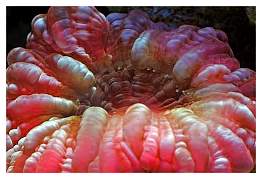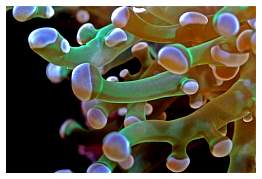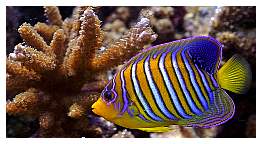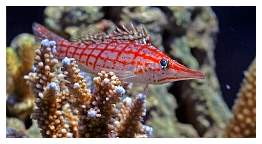|
Morten Nordby's (mortenN) Reef
Aquarium
Introduction:
When I opened the
email from Skipper I was confused. I looked at my calendar
and no, it wasn't April 1st. Then I understood that he had
found my tank and was asking me if he could use it as the
Tank of the Month. I was very proud to be asked, since the
tank was only 14 months old at the time. I never thought it
was possible to build a system that would be considered Tank
of the Month quality in so little time. I must give special
credit to all the people on Reef Central who have responded
to my questions the many times I needed help. I give a lot
of credit to my wife, Elisabeth, who is also interested in
saltwater aquariums and provides so much help to make this
all possible.
I started my first saltwater tank in 1980. I have been in
and out of the hobby a few times due to work-related issues,
but my interest in marine aquariums has never waned. Today
we are living in a different world with so many more technical
enhancements, which is one of the things, along with 25 years
of trying and testing, that made it possible in only 14 months
to get onto Skipper's mailing list. Thanks again!
My philosophy for this tank was to create a small-polyped
scleractinian dominated, bare-bottomed tank with a few special
fish. In my 25 years of involvement in the hobby I have tried
various fish-only tanks, fish with soft corals, fish with
fleshy, large-polyped species, soft corals and small-polyped
species at the same time. I have also been a keen do-it-yourselfer.
In my early years of involvement in this hobby it was not
possible to go to the local fish store with my credit card
and buy what I needed, and I think this has given me a wider
understanding of what it takes to make a saltwater aquarium
succeed. In this 90-gallon tank I have tried to use all I
have learned since starting in the hobby.
System Profile:
|
|
Main tank: 337 liters (90-gal.) - 75cm
W x 60cm D x 75cm H, standard glass |
|
|
Sump:
D.I.Y. 113.5 liters (30-gal.) |
|
|
Fragment
tank: 113.5 liters (30-gal.) |
|
|
Return
pump: Deltec 5250 |
|
|
Water Movement:
I use two Tunze 6100 Stream pumps
in the main display tank. I run them at 100% - 30% in five-second
intervals. I will say the Tunze Stream pumps were a tremendous
technological advancement for devotees keeping small-polyped
species. Although there is no good place in a 90-gallon cube
to hide the Tunze Streams, I have become accustomed to their
size and don't notice them anymore.
Water Parameters:
Water
Parameters:
|
|
Temperature:
~ 27° C |
|
|
Specific
Gravity: ~ 1.026 |
|
|
pH:
~ 8.3 (day), ~ 8.15 (night) |
|
|
Calcium:
390 - 420 ppm |
|
|
Alkalinity:
9.6 - 10.0 dKH |
|
|
Magnesium:
1350 - 1400 ppm |
|
|
Sr:
16 - 22 ppm |
|
|
PO4:
0 |
|
|
NO3:
0 |
|
|
|
I apply most of my time to cleaning
the water to provide the fish and corals with low nutrients
and clear water. Visitors sometime comment that my fish are
"flying in air;" they cannot see the water. Maybe
I am unusually strict with water quality, but it works for
me.
I use RO/DI water and Tropic Marin™ PRO REEF salt. Kent
carbon is used continuously in a 100 micron filter sock. The
sock is changed every three days when the carbon (three tablespoons)
is replaced. A 39-watt T5 UV sterilizer runs continuously.
A Deltec FR509 fluidized chamber with ROWA®Phos
media is used to control phosphate levels. I always use big
skimmers with ozone and ORP control. I have the skimmer set
so that it produces a wet skimmate and have done this for
the last ten years in all of my various tanks. A 10% water
change is performed every week. The only additives used are
Kent™ Turbo Strontium, Salifert™ Amino Acids and
Seachem Magnesium.
Equipment:
This tank was originally skimmed by
a Deltec AP850 for the first five months of operation, but
I later changed to a Deltec AP902. Currently I am experimenting
with a Deltec AP1004 in the setup. The tank has gotten better
and better, with less algae and detritus. The real reason
for my latest skimmer update is that I am planning to upgrade
to a larger tank.
An IKS Aquastar™ computer is my system's "brain."
The IKS monitors the tank's temperature, the pH of the kalk
reactor, measures the salinity and pH in the main tank as
well as controlling the ORP, the lights and top-off water
additions. Using a combination of the IKS, some dosing pumps
and ancillary equipment makes it possible to have very stable
water parameters. To provide calcium and alkalinity to the
tank I use a Deltec PF601S kalk reactor and KM500S kalk stirrer.
I use A.R.M media in my reactor and E.S.V. calcium hydroxide
in the kalk stirrer. The kalk reactor runs at pH 6.5 during
the day and 6.7 at night (the IKS controller can have separate
day/night parameters). I discovered this provides a more stable
Kh over a 24-hour period. I also use a P.O. "dual"
chamber containing A.R.M media, located after the reactor,
to raise the pH by 0.2 in the return water back to the sump.
A chiller? I don't need this in Norway; we have two winters,
one white and one green. I also have my sump and equipment
located in the basement and this is always cold so I have
no problem at all with overheating.
Lighting:
I prefer Giesemann NOVA II lamps
and use them because of their compact size. I need two lamps,
and with these I also have enough room for four T5 24-watt
bulbs. I use Giesemann double-ended 250-watt 14,500 K MegaChrome
coral bulbs. The T5s consist of three D & D actinic and
one 10,000 K. One of the armatures is dimmable, and I use
the IKS controller to run a sunrise and sunset photoperiod.
Photoperiod:
Sunrise starts at 11:00AM with the
T5 actinic + 10,000K.
The second bank of T5s (2 x actinic) come on at 11:30AM.
The metal halides turn on at 12:00 noon.
The metal halides turn off at 11:00PM.
The second bank of T5s turn off at 11:30PM.
Sunset starts at 11:30PM and the tank becomes dark at 12:00AM.
Corals:
I only have two large-polyped stony
corals. The frogspawn is a fragment from a friend, and I can't
wait to see how big it will be after several years have passed.
This is the only reason I have a large-polyped species in
my tank. My wife and I both like small-polyped species and
feel that in a 90-gallon tank the large-polyped species and
soft corals would take up too much space, given that we love
the small-polyped species so much. We have an extensive variety
of small-polyped species; Acropora is our favorite,
but we also have Montipora, Pocillopora, Seriatopora,
Stylophora and many more.
 |
 |
Today the system contains about 80 different kinds of small-polyped
species, most of which were grown from fragments or small
colonies. There are roughly 50 in the main display; the fragment
tank houses about 30. In a 90-gallon it's very problematic
to find the best spot for all the corals, so we have moved
them around to find the best place. Also, we often place some
of the small-polyped species into the fragment tank for a
time. I have tried to find the scientific names of all of
my corals, but this is a very big job so today we don't have
all of their names. Some small-polyped species, especially
Acropora, the vendors also give different names, so
I have a kind of Acropora under three to four different
names... precise naming is impossible if you don't spend a
lot of time trying to identify them.
The only problem I have seen with my corals occurred in February
of 2005… red bugs. Many thanks go out to the guys at
Reef Central who gave me the necessary help to cure these
pests with Interceptor™. Although maybe not truly a "problem,"
my corals grow out of my tank, but this is a luxurious problem.
I also let them grow on the glass so I can move them to a
bigger tank later.
Fish:
My favorite fish has always been Pygoplites
diachantus. Today, we have two of them in our tank. The
first one has lived in the tank from the start and the second
has now lived in the tank since February of 2005. They both
were acquired from an export company in Bali. Based on information
provided by the exporting company, one of them is from the
Indian Ocean; the other from the Pacific. The Pacific Pygoplites
are colored with especially asymmetric stripes so we are in
suspense over how this fish will look with the passing of
time. Pygoplites is a very nice fish, but they can
sometimes be somewhat reclusive.
 |
 |
|
2- Pygoplites diacanthus (Regal angel)
1- Zebrasoma gemmatum (Gem tang)
1- Acanthurus japonicus (White-faced tang)
1- Naso literatus (Naso tang - Red Sea)
2- Gramma loreto (Royal gramma - male and female)
1- Labroides dimidiatus (Striped cleaner wrasse)
1- Serranus tortugarum (Chalk bass)
1- Macropharyngodon bipartitus (Leopard wrasse)
1- Pseudochromis fridmani (Orchid dottyback)
1- Salarias fasciatus (Lawnmower blenny)
1- Centropyge loriculus (Flame angel)
1- Oxycirrhites typus (Longnose hawkfish)
|
For many years I searched for a Zebrasoma gemmatum,
but in Norway there are very few places to find fish. Surprisingly
enough, while on vacation in Germany, we found this fish and
bought it there. When I introduced the Z. gemmatum
to the tank, I removed the Acanthurus leucosternon.
The Acanthurus leucosternon had lived in the tank from
day one, so I was afraid it would kill the new Z. gemmatum.
At some point in the future, I will try to introduce my Acanthurus
leucosternon again. I also like to experiment with different
angelfish to find out if they are reef safe. Although this
is a big risk for my corals, somebody must try it to find
out. The price I must pay, however, is some wrecked coral
tips and periods of the corals' reduced polyp extension.
Feeding:
Daily, we use pelleted Ocean Nutrition's
Formula One and Formula Two as well as Kent platinum Herbivore
and Carnivore. We also use an assortment of frozen food, which
fluctuates based on what the local fish store has available,
but we try to vary the offerings so the fish do not eat only
one type of food. I want the fish to be healthy so we feed
often and in small quantities, three to four times a day.
Other Invertebrates:
We also have four
Tridacna crocea and one T. maxima. The T.
crocea clams are placed on the bottom of the tank at 75
cm deep. They all have good health and growth even with their
deep placement in the tank. There are nine shrimp: four Lysmata
debelius, four Lysmata amboinensis and one Stenopus
hispidus. I bought only a few snails a year ago, and they
have done a good job of controlling diatoms and have reproduced
prolifically. I don't have any hermit crabs in the system,
and of course, I have seen some algae, but we also find algae
on a natural reef. A little bit, I can accept.
For more photos and information, visit Morten's
website www.coralreef.no.
All photos © Morten Nordby.
Feel free to comment or
ask questions about my tank in the Tank of the Month thread
on Reef Central.
|
If you'd like
to nominate a tank for Tank of the Month, click here
or use the button to the right.
|
 |
|

